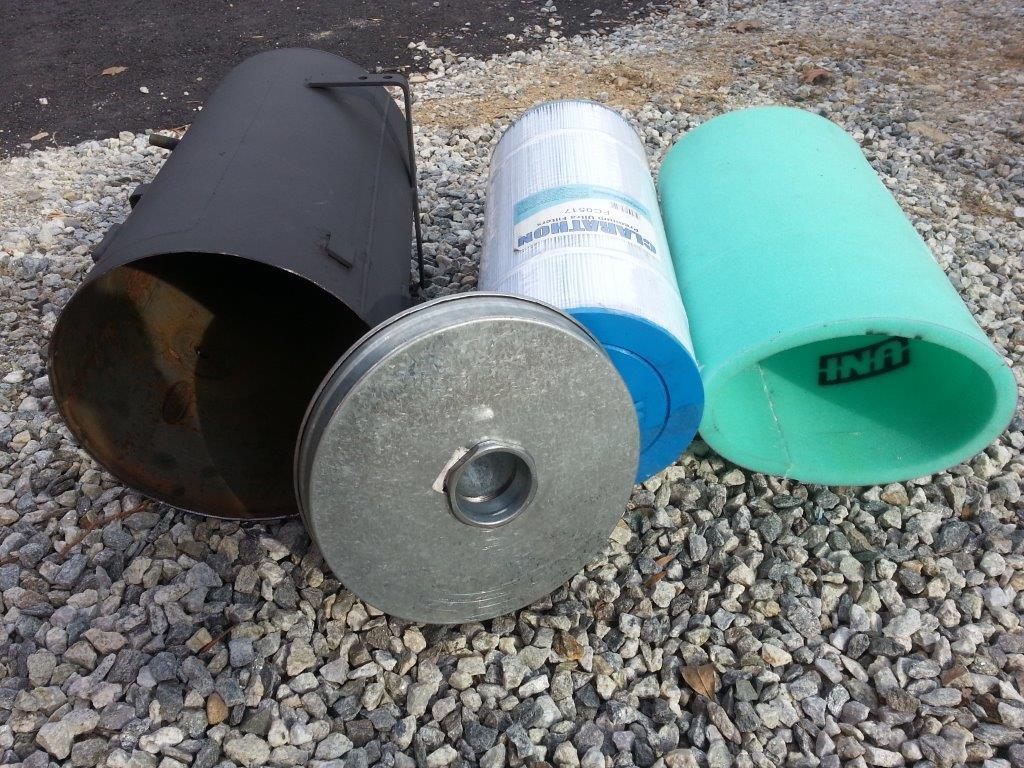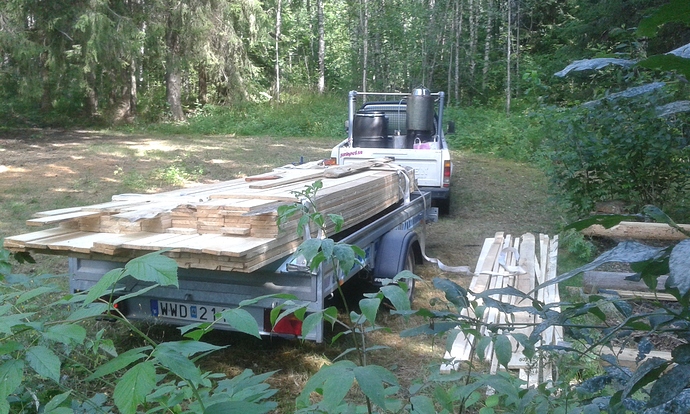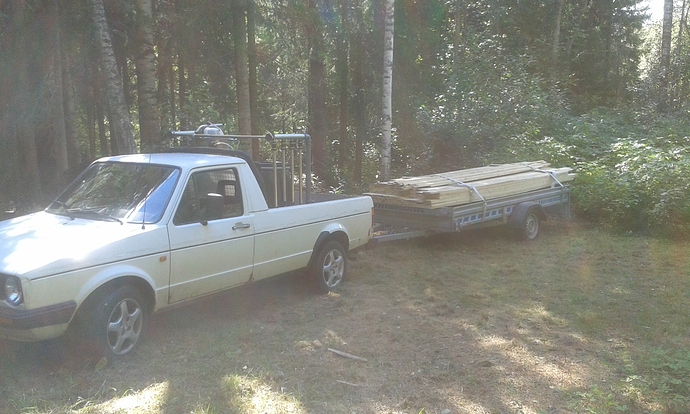Yes i have that white stuff rather bad at times. One time I sprayed it with carburetor cleaner and that was bad. It kind of gummed things up for a while and I would have to literally tap the butterfly shaft to unstick in the morning. Eventually, I got back to normal so now I just wire brush things with small wire brushes. TomC.
I learned that lesson the hard way also
Sprayed some penetrating oil into the throttle body to free up the sticking
Made the soot build up and stick even worse
Had to burn and scrape it all out
A little torch action at 500+ miles seems to do the trick
Hi, Kristijan!
8.8.2016
Woodgas of wood has to be cooled to as low a dew point as possible; so it is wet!
Wet gas cannot flow through a paperfilter.
Wet woodgas will not dry without considerable heat added!
A paperfilter does not dry in wet gas just by beeing in a warm place!
Reheating wet woodgas needs a hot surface contact
with a useful area. After cooling and condensing a “revisiting” to a cyclone-mantel or other hot component.
Then through an individual filter for gas only!
After that, dispensing in a double throat throttle body and followed by mixing. No crankcase ventilations below the double flap dispensing!!!
Ahhhhh!! Rant on my friend. Last trip out I got a quart of charcoal dust out of my cyclone in about 35 miles. I know much smaller stuff is going on up to my TBI as it is visible when I remove the air cleaner.
As usual, I am, and will study your every word and probably end up making a hand sketch to see if I am really visually understanding what I am reading.[quote=“gasman, post:318, topic:1928”]
Everybody is prompt about air filtering with paper filters,
[/quote]
By “prompt” do you mean we a quick at dismissing the use of paper or that we are quick to accept it. I believe you are saying we dismiss the use of paper.
Do you have any pictures of such a set up? I mean, how big of a paper filter are you recommending. If we took an old carburetor air filter with a paper cartridge, and ran the gas into the air horn and out where the carburetor attaches, would that be large enough? ( I am thinking you have something bigger in mind ) I have used on diesel trucks paper filters that are about 10 inches in diameter and 12 or so inches tall. That could be placed in a regular bucket. As I recall those truck paper filters are a little expensive, but I’m sure if blown out on occasions they would last a life time TomC
Hi, Tom!
8.8.2016
By “promt” I meant conscientiously using airfiltering!
But neglecting gasfiltering! Just using medium filtering for gas!
Once again:
It would be easy to take the wet gas from the hayfilter into a mantel partly surrounding the heatexchanger and then straight to an attached warm “bucket” with the easy serviced large paperfilter. As would be applied on a WK system.
Allrihgt?
Filter size, surface twice what is used for air filtering.
Dimensions: Higher than diameter, suitable in an easy-openable “bucket”.
Max is of course right about heating gas for paper filtering to prevent water fouling. I’m using charcoal gas which usually has less water. I’m trying to cheat by trying to get the moisture out ahead of my filter. I run my gas through a cooler/coalescer/agglomerator then over silica gel for more moisture capture. I’m using a large pleated paper filter designed for filtering spa water (8"X18"–150+ square feet of surface) . I’ve covered it with oiled foam filter media. I’m interested in any thoughts about this setup. I hope to test run the MG gasifier on Saturday if weather permits.
Tom, if you would just stack up regular truck filters they would do the same thing. I would think that the bottom ones would get dirty the quickest. You could then rotate them out.
Bob
Hi, Bruce!
9. of August 2016
Using cooling surfaces, you can approach the ambient temperature with the gas, but never reach it, without using additional outside “evaporation” as an extra heat absorber!
Evaporating water from some thin textile and pumped/sprayed over the cooler surface…
Look at old stationary agricultural motors!
On board a vehicle, sparce-wound thin rope on vertical cooler tubes, kept wet with slow water dripping might add to the cooling ability…
Silica gel or “chrystals” is binding you into a cycling work; binding/evaporating with heat. You never get loose from it.
Drip cooling gives more “free hands” and driving pleasure…
…
If the cooling makes condensation, you have to do the filtration before the final cooling, on an “intermediate” temp level (dry).
If the filter is intended for water filtering, then keep it vertical so it becomes partly “selfrinsing”! (All wet, after whole the cooler).
Don’t let ANY oil onto the paper! The pores of the structure is then like “asphalted”; no gas can penetrate!!!
Put the oiled foam in a separate bucket!
I was thinking why noone tends to use such a simple solution. We have a symilar cooler where l work and it works fine.
In my culculations the amount of woodgas required for a 1.6 l engine on full power culd be cooled with about 70ml/min of water if there is no other air cooling rail. I think l might just give it a try someday
Thanks Max. Wise and helpful as usual. I expect to observe the limitations of my current arrangement in a hundred miles or so. Misting my cooler would be an easy add.
Hi, Bruce!
9. of August 2016
You are welcome, thank you!
Very true.
It has also been said longer trips are more likely to cause constipation. I experience the opposite.
On a longer trip, at the end of hopper no 2, I start to get low vacuum ratios (2:1) and gas temp climb. I’ve come to the conclution that my tiny gasifier has to work harder on longer trips when speeds are high for a long period of time. Fuel passes fast downstream and hasn’t enough time to shrink. I think I’ll bring some smaller fuel on longer trips.
When on shorter trips it seems to accept between egg and tennisball size and still maintain 3:1 - 4:1. That’s the ratio I like to see.
Thoughts anyone?
Working on the 75%.
Hi, Jan-Ola!
11. of August 2016
Temperature measurings! Above and below restriction reviels what is going on…
Any white ash in odd places? Bit size on grate?
On the white crystal deposits seen in this area . . .
sometimes it is just zink/aluminum oxides from moisture’s after siting, shut down forming.
Other times in this running now changed over to low pressure area, it is a participate crystal forming out to the woodgas stream.
Some systems (Austrian-Genbacher) have reported and pictured yellowish crystal strands forming in their low pressure mixer throat areas under some conditions.
S.U.
I think you are right Steve. Zinc and aluminium tend to act most strangely under some conditions.
I worked in a factory laboratory in 2012 where they analysed a strange phenomenom of forming a spider web kind of threads on some electronical components, short circuiting them. They sent it to NASA institule only to find it was actualy microscopical zinc crystals forming a long thread!
Hi, Jan-Ola!
11. of August 2016
Measures, pictures, sizes!
I appreciate everyones help but analyses will have to wait. In the meantime I’ll just drive. The “work truck” is doing it’s job 
Making some money but more than that I see food for the VW laying on the ground in the form of stickers. That looks like a load for the little engine— must have more power available than one would think from a little Imbert. I love small.TomC
Going up a steep hill on my way home with my finger on the forbidden switch. I never turned it on 
It’s amazing what kind of work a few handfulls of chunks can do.


